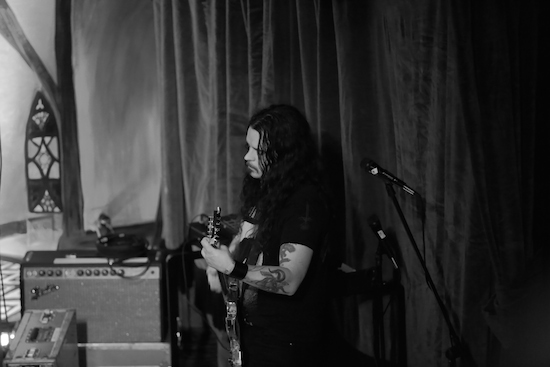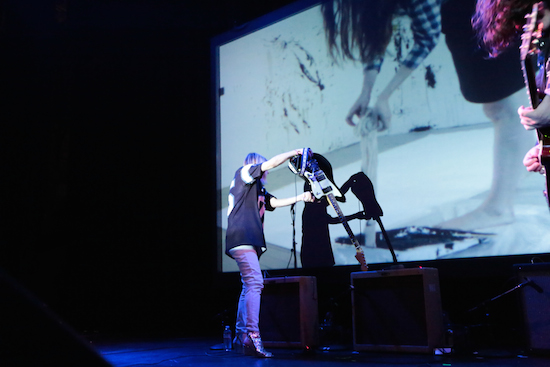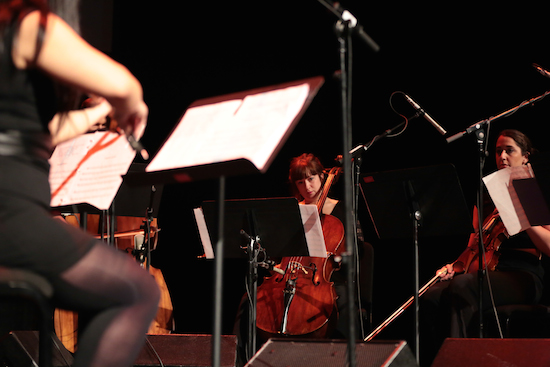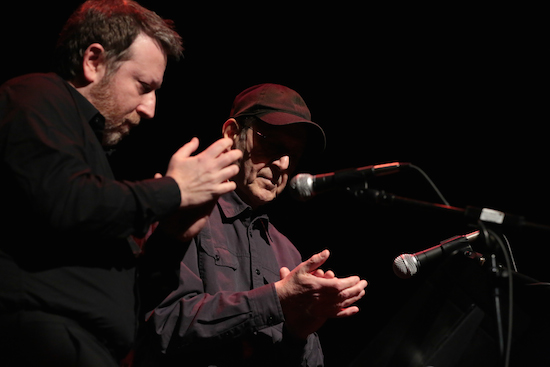Of all the American music festivals, Big Ears may be the strangest. Brainchild of Ashley Capps – founder of AC Entertainment, co-producer of Bonnaroo – the festival devotes three days to the cerebral, exploratory, and avant-garde. It’s unique among the American festivals in that it enlists musicians, not by genre, but their enthusiasm for provocation and their boldness to delve into the fringes of sound. What makes it more enigmatic is that it takes place in Knoxville, Tennessee. Not exactly the cosmopolitan playground that springs to mind alongside progressive weirdness. That said, Ashley Capps must have had a Field Of Dreams experience (‘If you build it, they will come.’) because it works.
Centred in the gorgeous downtown, where a Tennessee River breeze carries the scent of cherry blossoms, the festival utilises four venues within walking distance from each other. Scruffy City Hall, the club locale, is located within the city’s Market Square. Knoxville Museum of Art, the longest trek, amounts to a ten minute jaunt. The two main stages, the Tennessee Theatre and the Bijou Theatre, can be found along Gay Street, a few blocks from the ped mall. With origins back to the American Revolution, the Bijou is a midsize theatre, renovated in 2006. The Tennessee opened in 1928 as a movie palace and was immediately declared "the South’s most beautiful theatre." Hard to imagine that’s not still true. With a capacity of 1600, it’s the largest setting and reserved for the weekend’s headliners.
Opening night sees So Percussion, a four-piece percussive ensemble, jam with New York duo, Buke and Gase, who play a six-string baritone uke and guitar bass hybrid. Over at the Tennessee, Dean Wareham, and his backing band, play cuts off his bittersweet eponymous titled new record. Norway’s Susanna follow Wareham with songs reminiscent of a starker and more sullen Tori Amos. Over the weekend, many musicians take advantage of theatre space to combine sound and image, but in rousing contrast to everyone else, Tim Hecker decides to perform his ambient noise in a pitch-black Bijou.

A sizeable crowd at Scruffy City Hall – mostly bearded dudes in black-rimmed glasses, sprinkled with an older art contingent – waits to see what Stephen O’Malley, member of Sunn O))), is to deliver for his solo set. O’Malley emerges from the back and plants himself near the wall stage, right where he remains for the next hour, leaving the limelight to the two Orange 4×12 full stacks and two Ampeg 8×10 towers. He plugs in his guitar and dials up the volume. Warm fuzz rises from the arsenal of amps and lends weight to the air like humidity. O’Malley strikes a detuned chord, inspiring an older gentleman to high-five a college kid, and letting it ring out into pure tone and feedback.
The set is economical and effective – the last twenty seconds of every metal scorcher on repeat for an hour. Divorced from riffs or songs, the set strips all fat from the trappings of the genre, whittling down heavy metal to its essence. It’s contemplative experience that’s oddly spiritual. Around the fifteen or twenty minute mark, O’Malley steps on a pedal that boosts the bass frequencies, and vibrations from beneath the refinished floorboards rise through the audience’s feet and up through their bodies. Members of the fold and the newly proselytised allow the tube-driven ohm to wash over them – perhaps taking them to wherever the Great Old Ones slumber.
Later, Colin Stetson greets Scruffy City’s intimate room to enthusiastic cheers in an unassuming white t-shirt. After a false start, the saxophonist gets down to business. And what serious business it is. Stetson is a revelation – a rare musician whose technical prowess matches his vision, composition, and ear for an infectious hook however unorthodox. He’s a one-man-band that transforms the tenor and bass sax into percussive instruments, incorporating classical, avant-garde jazz and modern electronic music. Imagine Ornette Colman re-interpreting The Downward Spiral.
Steston’s songs often build on an ostinato phrase that intensifies into more outside territory, utilising circular breathing to approximate beat box, turntable scratches and computer manipulations, off the cuff remix techniques as segues into different motifs – all without the aid of a sampler. On record he plays through effects pedals, but even on Friday night with the gain knob dialed down, there are times when Stetson’s tonality has a mechanical, almost futuristic, quality. Though esoteric, his playing is soulful and he fully commits to leave everything on stage. He burns through a visceral set that includes ‘Judges’, ‘The Righteous Wrath Of An Honorable Man’, and a profound version of the haunting ‘Part Of Me Apart From You’.

Experimental guitar duo Body/Head’s setup at the Bijou is bare bones – three Fender Deluxe and several pedals. It provides an interesting counterpoint to O’Malley’s approach – instead of overpowering the room with volume, Kim Gordon and Bill Nace’s combo amps fight to penetrate the space.
While looser than anything on Coming Apart, the performance retains the album’s darkness and emotional resonance. The set feels completely improvised, more atmosphere and texture than noisy assault, all bell chime arpeggios, pick scrapes, and percussive tapping, no element ever repeating enough to establish a motif or groove before moving on to another idea or dissolving into the undertow of feedback that held everything together.
Bill Nace is the more rambunctious of the duo, bobbing his head as he stomps about, shaking or smacking his guitar neck, often turning his back on the crowd to entice more hum from the amplifier. Kim Gordon is stoic and subdued, occasionally stepping to the mic in silver glitter pumps to deliver her strained croon with the same expressionless face she holds all night. Near the end of the set, she becomes more active and retrieves a harmonica from behind the amps, briefly playing it through a distorted mic. It is, perhaps, the most abrasive sound of their time on stage.
For the duration, the two guitarists are framed in the glow of a film screen behind them. An art house vignette intercut slo-mo close-ups of a girl and boy leering into the camera. The narrative, if it could be described as such, culminates in an art studio where the boy, camera in hand, hovers over the girl laying on a blank canvas on the floor. In the next shot, she removes her stockings, dipping them into black paint, and then splashing the canvas. Gordon meanders back to the Tweeds, carefully stepping up and stabbing her guitar’s headstock into the amps, the spotlight throwing the guitar’s shadow over the image of the stockings. Even here, in the midst of punk cliché, Gordon remains detached.
Hailu Mergia and Low Mentality close Friday night at Scruffy City Hall. Mergia, a member of 70s East Africa’s Walias Band, became a cab driver in Washington, D.C. after leaving the band on a US tour in the early eighties. His 1985 solo album, Hailu Mergia And His Classical Instrument, remained in obscurity, along with Mergia himself, until only last year when Brian Shimkovitz, the man behind Awesome Tapes From Africa, obtained a copy and reissued the album. Since then, Mergia has hooked up with Nikhil P. Yerawadekar’s Low Mentality from Queens, NY.
Big Ears marks their fourth live performance. Not that you could tell. They sound like they’ve been jamming together for a decade. After the day’s forays into musical abstractions, it’s a joyous end to the evening, the tight groove-oriented Afrobeat set list a reminder of music’s ability to strip away pretense and bring people together for a good time.
Saturday’s schedule brims with music. Fans, undaunted by perpetual rain, are determined to see as much of it as possible. Bijou hosts sets from Oneohtrix Point Never, Low, and Laraaji’s cosmic zither. Meanwhile, Brooklyn trio Dawn of Midi lay down some jaw-dropping all-acoustic jams that’s somewhere between jazz and trance.

According to their website, New York-based Wordless Music Orchestra are the house band of their Wordless Music Series, which aims to break down "the various boundaries and genre distinctions segregating music today –popular and classical; uptown and downtown; high art and low." If their MO could be judged strictly by audience attendance, they’ve succeeded –the young and tattooed share the packed Tennessee Theatre with the art crowd and classical music fans.
The seven black-clad musicians perform selections from Jonny Greenwood’s film scores. The majority of the selections are from Messiaen-inspired There Will Be Blood – opening with the melancholy crawl of ‘Prospector’s Quartet’ and impassioned renditions of the urgent and playful plucking of ‘Future Markets’ and the maddening ‘Oil’ – but they make their way through Norwegian Wood’s ‘Reiko’ and ‘Application 45’ from The Master. ‘Muta Aini Kuru Kara Ne’ is a stand out. Its bleak romanticism sounds amazing inside Tennessee’s acoustics.
The group supplement Greenwood’s material with Giacinto Scelsi’s ‘Duo For Violin And Cello’ featuring Harris and Snow, and Harris goes solo for ‘Mikka’ and ‘Mikka 5’ from Iannis Xenakis. The set, however, belongs to ‘Detuned Septet’ which has the musicians bouncing up from their chairs with violent strikes to their instruments, and something close to classical head banging. Greenwood joins the group for a two song finale. ‘Self-Portrait w/ 7 Fingers’ includes an interesting use of audience participation and as he plugged in his telecaster, a screen above the musicians invited, "To participate in the following piece, please enter this URL into your smartphone." The piece had an astral sensuality, something that would have fit well on In Rainbows. The audience smartphones, adding a cold firefly glow in the dimmed theatre, delicately punctuate the music with beeps and chimes like alien tones from Close Encounters Of The Third Kind. ‘Loop’, the closer, built on Robert Fripp-esque repeats guitar lines over the Wordless Music Orchestra’s lethargic bowing.

Perhaps the most inspired set is also the most caustic and polarising experience of the entire three day festival. It’s after 1am when Nazoranai––the super group made up of Keiji Haino, Oren Ambarchi, and Stephen O’Malley––finally take to Bijou’s stage. Ambarchi, a dead ringer for H.P. Lovecraft, claims the throne behind the kit. His drumming, driven by steady ride rhythms and tom loops, is the jazz-influenced foundation on which KH and O’Malley explore the nether regions beyond convention. O’Malley runs his bass through an arsenal of pedals, using a bow to wrench growls, rips, and clangs from the instrument in lieu of any discernible groove.
But Mr. Haino is the obvious conductor of the storm. The genuine eccentric begins on a wood flute filtered by effects pedals. But this isn’t Jethro Tull. Ear-piercing dissonance ricocheted off the acoustics. Later, he moves on to scream sweet nothings into a mic for some time before plucking atonal lines from a capoed SG. Throughout the hour, Mr. Haino communicates to the other musicians via non-verbal cues, at one point, baiting Ambarchi––already near collapse––to up his intensity.
If nothing else, Hanio is at heart a committed showman. This is clearest when, at the performance’s climax, he ventures to a table loaded with effect pedals connected by something akin to a Theremin that allows control without physical contact. There he transforms into a bizarre-o alchemist––part DJ, part performance artist––employing ravenous hand gestures and dramatic poses to summon aural fireworks from the device as if it were arcane technology. He contorts his body. Grey hair whips the air. Neck veins billow with blood. By the show’s end, the man is breathless. Those audience members with the wherewithal to stay leap into a well-deserved standing ovation.
Sunday begins with a massive crowd at the beautiful Knoxville Museum of Art. Stephen O’Malley and Oren Ambarchi perform two compositions––written specifically for them––by modern giants Alvin Lucier and Iancu Dumitrescu. Wordless Music Orchestra follow them with John Adams’ Shaker Loops. In the afternoon, Scruffy City Hall hosted solo sets from Keiji Haino and outsider pianist Lonnie Holley. The Bijou closes its guest list with Rachel Grimes, accompanied by cellist Helen Money and saxophonist Jacob Duncan, offering a batch of haunting chamber-music before So Percussion finished with Bryce Dessner’s Music For Wood And Strings.

American composer Steve Reich headlines the festival, giving a three hour capstone at the Tennessee Sunday night. Reich and Brad Lubman, Ensemble Signal’s Conductor, began the evening with Clapping Music, composed in 1972. Jonny Greenwood follows with Electric Counterpoint originally commissioned for, and recorded by, Pat Methany in 1987. The piece requires the soloist to play against fourteen pre-recorded guitar tracks (two of them bass). Greenwood does a bang up job, despite some unfamiliar audience members being certain he was somehow "cheating".
In Radio Rewrite Reich takes on Radiohead. Reich uses Jigsaw ‘Falling Into Place’ and ‘Everything In Its Right Place’ as a diving board into his own obsessions. Those expecting something in the Apocalyptica vein would be disappointed. But the outcome may be his most dramatic work. NY-based Ensemble Signal finish with a stunning version of Reich’s seminal Music For 18 Musicians. The piece, originally premiering in 1976, was a fitting closer for the weekend, lulling the audience into a hypnotic state by Reich’s trademark use of phasing and repetition.


